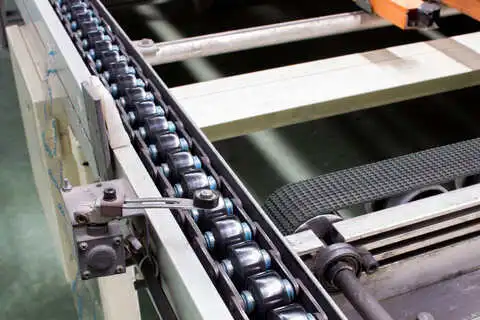Steel Cord Belt Conveyor Standards

Standards for steel cord reinforced conveyor belts specifically address the considerations that are unique to them. Very durable due to their design, steel cord conveyor belts are thus used in environments and for payloads where the demands are high enough to warrant their use, therefore requiring thorough test methods that goes beyond what other conveyor belts are subjected to, in addition to tests that look at the bonding of the steel components to the rest of the conveyor belt.
ISO 15236-1:2016
Steel cord conveyor belts - Part 1: Design, dimensions and mechanical requirements for conveyor belts for general use
ISO 15236-1:2016 specifies the performance and constructional requirements applicable to conveyor belts having steel cords in the longitudinal direction as reinforcement. The requirements for construction given in Clause 6 apply to the design of single belts, as well as the design of complete type series such as those covered in ISO 15236 2.
ISO 15236-2:2017
Steel cord conveyor belts - Part 2: Preferred belt types
ISO 15236-2:2017 specifies preferred types of conveyor belts with steel cords in the longitudinal direction as reinforcement. The belt type series in this document are based on the general requirements for construction given in ISO 15236 1.
ISO 15236-3:2017
Steel cord conveyor belts - Part 3: Special safety requirements for belts for use in underground installations
ISO 15236-3:2017 specifies the performance and constructional requirements applicable to conveyor belts for underground mining having steel cords in the longitudinal direction as reinforcement. The requirements for design and construction apply to the design of single belts, as well as the design of complete type series such as those covered in ISO 15236 2. Steel cord belts in accordance with this document are intended for use underground in coal mines and in other applications where the highest demands for safety against fire and explosion hazards have to be complied with. NOTE At present, the requirements can only be met by the use of compounds based on chloroprene rubber for the covers, as well as for the bonding rubber.
ISO 15236-4:2004
Steel cord conveyor belts - Part 4: Vulcanized belt joints
ISO 15236-4:2004 specifies design, dimensions, requirements and marking of vulcanized joints for steel cord conveyor belts.
ISO 7590:2018
Steel cord conveyor belts - Methods for the determination of total thickness and cover thickness
This document specifies three methods for the measurement of total belt thickness and the thickness of covers of steel cord conveyor belts. Methods A1 and A2 (micrometer methods) can be used for all steel cord conveyor belts for the measurement of both total belt thickness and cover thickness. Method B (optical method) is intended for the measurement of cover thickness only. It is not suitable if there is a textile or metal weft, nor if the ends of the steel cords become twisted when cut.
ISO 7622-1:2013
Steel cord conveyor belts - Longitudinal traction test - Part 1: Measurement of elongation
ISO 7622-1:2013 specifies a method for the determination of the elongation of steel cords constituting the carcass of conveyor belts, when subjected to a force corresponding to 10 % and 60 % of the specified tensile strength. It applies exclusively to conveyor belts with a steel carcass.
ISO 7622-2:2015
Steel cord conveyor belts - Longitudinal traction test - Part 2: Measurement of tensile strength
ISO 7622-2:2015 specifies a method for the determination of the tensile strength, in the longitudinal, of steel cords constituting the carcass of conveyor belts. It applies exclusively to conveyor belts with a steel carcass. NOTE A method for the determination of elongation is specified in ISO 7622 1.
ISO 7623:2015
Steel cord conveyor belts - Cord-to-coating bond test - Initial test and after thermal treatment
ISO 7623:2015 specifies a method for determining the bond strength of metal cords to their surrounding coating, either in the initial state or after thermal treatment. It applies exclusively to metal-carcass conveyor belts.
ISO 8094:2013
Steel cord conveyor belts - Adhesion strength test of the cover to the core layer
ISO 8094:2013 specifies a test method for determining the adhesion strength of the cover to the core layer. It applies exclusively to steel cord conveyor belts.
BS EN ISO 8094:2013
Steel cord conveyor belts. Adhesion strength test of the cover to the core layer (British Standard)
ISO 8094:2013 specifies a test method for determining the adhesion strength of the cover to the core layer. It applies exclusively to steel cord conveyor belts.
BS EN 13827:2003
Steel cord conveyor belts. Determination of the lateral and vertical displacement of steel cords (British Standard)
This European Standard specifies methods for the determination of the mean lateral displacement between cords, and for the determination of the vertical displacement of cords relative to a mean level of steel cords within a conveyor belt as described in prEN ISO 15236-1.





